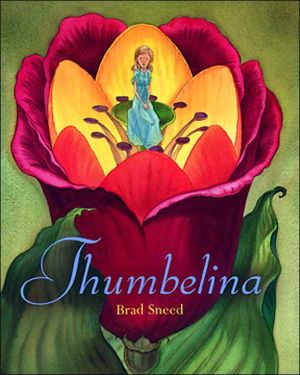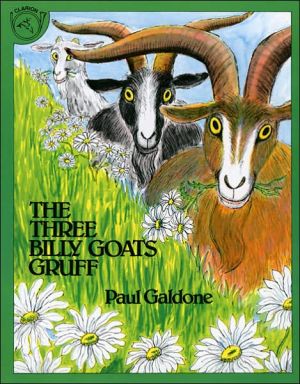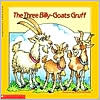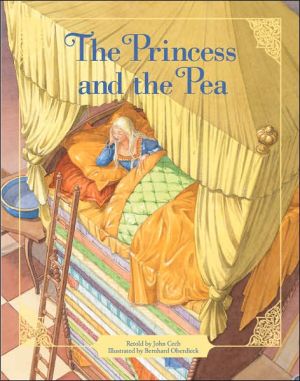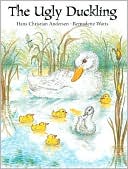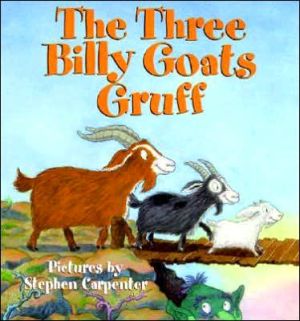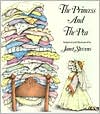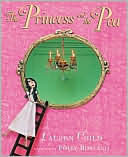Thumbelina
It's not easy being small, but in Brad Sneed's lovely new adaptation of Hans Christian Andersen's Thumbelina, at least life is full of adventure. Soon after being born from a fiery red flower, Thumbelina is kidnapped from home and pursued by many suitors, including a horrible toad, a bumbling beetle, and a grumpy mole—until the plucky heroine finds a true love who fits her just right.\ Sneed's rich, detailed watercolors are a true standout, illustrating the animals and natural world with...
Search in google:
The Danish dreamweaver's story of the tiny girl no bigger than a thumb is provided here in its entirety, but the book's squarish design, in which the text is presented in solid blocks, draws the reader's attention to the exceptional art. Lovely, lean, lithe lines combine with a palette of tawny earth tones to create a minimalist world redolent with grace and rich with imagination.Publishers WeeklyThe larger-than-life adventures (relatively speaking) of Hans Christian Andersen's Thumbelina unfold in Brad Sneed's illustrations. Tiny Thumbelina endures abductions by frogs, a beetle, a mouse and a mole before finding her soul mate. Sneed's animals are often grotesque (as befits their personalities) yet emotionally expressive, though the human characters come across less so. Copyright 2004 Reed Business Information.
Once upon a time there was a woman whose only desire was to have a tiny little child. Now she had no idea where she could get one, so she went to an old witch and asked her: "Please, could you tell me where I could get a tiny little child? I would so love to have one."\ \ "That is not so difficult," said the witch. "Here is a grain of barley; it is not the kind that grows in the farmer's fields or that you can feed to the chickens. Plant it in a flowerpot and watch what happens."\ \ \ \ Excerpted from Thumbelina by Hans Christian Andersen. Translation copyright (c) 1974 by Erik Haugaard. Illustrations copyright (c) 1996 by Arlene Graston. Excerpted by permission of Delacorte Press, a division of the Bantam Doubleday Dell Publishing Group, Inc. All rights reserved. No part of this excerpt may be reproduced or reprinted without permission in writing from the publisher.\ \
\ Publishers WeeklyThe larger-than-life adventures (relatively speaking) of Hans Christian Andersen's Thumbelina unfold in Brad Sneed's illustrations. Tiny Thumbelina endures abductions by frogs, a beetle, a mouse and a mole before finding her soul mate. Sneed's animals are often grotesque (as befits their personalities) yet emotionally expressive, though the human characters come across less so. Copyright 2004 Reed Business Information.\ \ \ \ \ Children's LiteratureLarge, lush pictures illustrate this classic tale of a maid no bigger than a thumb. Flowers and plants seem very spacious for this tiny creature as the story is both told and seen from Thumbelina's point of view. The ugly frogs tower over her as they tell her of preparations for her marriage into the frog family. She is barely visible as the fish chew through the stem holding the lily pad. As she is floating down the river enjoying her freedom, a ferocious beetle grabs her and flies away. He sets her free when the other beetles taunt him about Thumbelina's strange appearance. Even the field mouse that Thumbelina lives with through the winter is large in comparison to her tiny size. Fortunately, a bird friend rescues her from an upcoming marriage to a mole. The wren gently drops her into a flower. To her surprise, a diminutive fairy king greets her. Then all of the flowers open and the tiny people of his kingdom emerge. Among the many gifts they bring her, she finds a pair wings. Now Thumbelina and her new husband can fly from flower to flower together. An unusual conclusion to the tale has the wren telling the story as she sits on a windowsill. A man (Hans Christian Andersen) inside the room is writing it down. This is a lovely addition to the collection of Andersen's tales. 2004, Dial, Ages 5 to 8. \ —Phyllis Kennemer, Ph.D.\ \ \ Children's Literature\ - Mary Quattlebaum\ The idea of teeny-tiny people enchanted me as a kid and I loved reading about Thumbelina, the girl who sprouted in a flowerpot and had to brave the huge, dangerous world before finding happiness with others her size. Erik Haugaard's unabridged translation of Hans Christian Anderson's Thumbelina captures the magical, musical quality of the original, with Arlene Graston's pastel-hued illustrations a lovely accompaniment.\ \ \ \ \ Children's Literature\ - Sharon Oliver\ This beautifully illustrated retelling of Andersen's classic tale from the "We Both Read" series is surely to become a favorite. The series is written so that an adult and child can read designated parts, sharing the storytelling. The child-marked sections are short sentences, many of which repeat words from the adult section. Words that may be new or difficult for new readers are highlighted in bold in both the adult and child sections. The book is faithful to Andersen's story. What sets this version apart are the illustrations. The watercolor and pencil illustrations seem to bring the story off the page. Character facial expressions are easy to read, the colors change dramatically from the cheerful green forest to the mole's dark underground lair, and the lines are so fluid the drawings flow from one page to the next. The two-reader format is a great invitation for parent and child to read together, but this would also be a favorite for parent to read to child. If you do not have a beautiful version of Thumbelina on your shelf, get this one adapted by Sindy McKay. Reviewer: Sharon Oliver\ \ \ \ \ Children's Literature\ - Deborah Zink Roffino\ Hans Christian Anderson's poignant tale of a tiny girl kidnapped and trapped in the woods is retold here, flushed with violet-hued watercolors. Dizzying perspectives magnify wee Thumbelina's travails in the enormous world around her. Descriptive language breathes life into the adventures as she escapes her many captors and finally meets a whole society of folks her size.\ \ \ \ \ Children's Literature\ - Children's Literature\ This is a sweet and gentle retelling of Hans Christian Andersen's well-known tale of a thumb size young girl who appears magically in a flower. In her adventures she is captured by a mother toad, a June bug, and survives the winter by staying with a field mouse. Finally, she is delivered from marrying a grumpy mole by a cheerful sparrow and transported to happiness in the kingdom of flowers. The pastel-toned pictures complement this retelling, however it lacks excitement and Thumbeline desperately needs some gumption. In an age where girls are encouraged to be creative, energetic and intelligent in order to reach their goals, Thumbeline is a bland role model. Previously released in 1980 in Switzerland, this retelling would make a good calm bedtime story. Librarians may want to add this to their collection, if only to compare it with other versions of this familiar fairy tale. 2000, (orig. 1980), North-South Books, Ages 5 to 10, $15.95. Reviewer: Wendy Pollock-Gilson—Children's Literature\ \ \ \ \ School Library JournalK-Gr 3-Adhering closely to the original story, Sneed has streamlined the prose while keeping the sense and emotion of the tale, including the allusion to Andersen having heard it from a swallow nesting outside his window. The fanciful watercolor illustrations are full of decorative flowers, and the lanky Thumbelina has a contemporary look. The brightly colored, double-page depictions can be easily seen by listeners in storyhours. In the scene in which the fish nibble at the lily-pad stem to set Thumbelina free, the action is shown from an underwater viewpoint and readers see only her dangling legs-a nice touch. Close-up views show the tiny girl in comparison to the toads, swallow, beetle, and mole, giving children a sense of scale and setting. While other depictions of this character-including Brian Pinkney's brown-skinned Thumbelina (Greenwillow, 2003) and Susan Jeffers's delicate-looking protagonist and romantic backdrops in Amy Ehrlich's retelling (Dial, 1979; o.p.)-have served the tale well, Sneed's adaptation makes a good addition where extra copies are needed.-Susan Hepler, Burgundy Farm Country Day School, Alexandria, VA Copyright 2004 Reed Business Information.\ \ \ \ \ School Library JournalK-Gr 3\ The format into which this beloved fairy tale has been shaped has short blocks of text, meant to be read aloud by a parent sitting with a child, interspersed with single sentences or sentence fragments made up of one- or two-syllable words in a large font for youngsters to read. Since most of the text is intended to be read by an adult, there is a question as to whether or not the adaptation of Andersen's original work really needed to be so simplified, with little or none of the romantic atmosphere remaining. The illustrations are far more effective and evocative than the text (aside from the one that shows Thumbelina being flown over a modern city of high-rise structures). Gréban has preserved the delicate fairy-tale setting of the story while emphasizing its emotional transitions by the use of different qualities of light-the cold pale gray of the snowy winter, the warm brown of the cozy mouse dwelling, the light sifting through the soft green spring leaves of the tree where Thumbelina talks with the swallow. Still, the choppiness that results from trying to make this an interactive reading experience does not do Andersen's tale justice.\ —Copyright 2006 Reed Business Information.\ \ \ \ \ \ School Library JournalGr 2-5-- A credible translation of Andersen's Thumbelina. Although rather formal in tone, lacking the immediacy of Haugaard's colloquial language in Hans Christian Andersen: His Classic Fairy Tales (Doubleday, 1978), Riordan's smooth retelling presents the entire story without deviations or sweetening touches. In watercolors that have an unearthly glow, Thumbelina is portrayed as a fey creature, existing in a world of nature and fantasy. The illustrations tread this fine line well, contrasting the solid earthy browns of the fieldmouse and the mole with the translucent yellow-greens of the heroine. Fanciful touches, such as spiders in four-armed waistcoats who spin a tiny wedding dress, add to the fantastic aspect, while close-ups of natural plants and animals ground it in reality. Many editions of this story are in print, but most, such as Amy Ehrlich's (Dial, 1979; o.p.), abridge the tale, changing important plot elements in the process. An interesting version. --Karen K. Radtke, Milwaukee Public Library\ \ \ \ \ Kirkus ReviewsIn a new retelling of Anderson's tale of a tiny girl traded from frog to bug to rodent, adaptor and illustrator Sneed creates a lush, Lilliputian world of jewel-eyed insects and gargantuan flowers. The attentive creatures, all in love with the frail Thumbelina, are only slightly personified a la Wind in the Willows. Alternating between one- and two-page, full-bleed illustrations, Sneed uses perspective to great advantage, casting each creature as considerably larger than Thumbelina. As she sleeps alone in the forest, for instance, the leaves above her are huge and even a nearby caterpillar is twice her size. The spot illustrations that accompany the text also help to move the story forward, a tiny one of Thumbelina standing by the near-dead bird, emphasizing the moment of loss. Sneed's luminous watercolors make this a nice package. The text, however, does sometimes outpace the illustrations, which might cause confusion or questions. Not perfect, but collections in need of more Anderson will welcome this. (Picture book. 4-9)\ \
